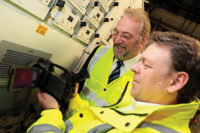Like any routine maintenance, inspecting, removing and replacing refractory in pre-calciners, cyclones, lime kilns, ISAMELT furnaces and other vertical vessels comes with a hefty price tag. Traditional scaffolding is often found to be the culprit for increased downtime and lost productivity in these situations.
Custom-manufactured suspended platforms can help reclaim maintenance efficiency. These lightweight, heavy-duty metal platforms are erected inside the vessel and raised or lowered using manual or electric hoists for hassle-free maintenance and relining applications. They also provide a number of productivity and safety benefits throughout the maintenance process. Here’s how.
Setup is a snap
Erecting a scaffolding system is its biggest deterrent and the greatest drain on maintenance productivity. Erection times vary based on vessel size and configuration, but even with an experienced crew, scaffolding can take several shifts all the way up to an entire week to construct — putting significant stress on maintenance budgets and timelines.
Suspended platforms featuring a modular design and pin-together construction offer a simpler solution that can be set up in as little as two hours. Modular components easily fit through a 560-millimeter (22-inch) diameter access hole and are much easier to maneuver than long planks and poles. Additionally, using heavy-duty, aircraft-grade aluminum provides the same strength as steel but at a third of the weight, resulting in pieces that weigh 18 kilograms (40 pounds) or less. And where welded joints on a scaffolding system are rigid, pin connections on suspended platforms provide flexibility for raising or lowering, reducing stress on risers at platform joints. This helps maintain safety and stability while improving assembly times and platform strength.
In just a few uses, the time and effort saved in setup alone by using a suspended platform add up to significant ROI potential. For example, a cement facility eliminated five days of double shifts when installing a drip tube in a cyclone, saving an estimated $15,000 an hour in downtime. In another example, a copper plant replaced the scaffold system for their smelter with a suspended platform, increasing productivity and safety. Overall, the plant was able to save 320 man-hours per shutdown with the new system.
Move it
Productivity benefits continue to add up after the platform is assembled. In terms of surface area, ease of use and access to the work area, suspended platforms are on another level.
With scaffolding, tools and materials such as refractory brick, gunning equipment and other necessities need to be hoisted up to working height — a slow process with a heavy physical toll that limits productivity by restricting supply lines.
The open design of a suspended platform, on the other hand, provides ample space for personnel, tools and materials. This allows several workers to operate in the same area comfortably, as well as have everything they need close at hand for efficient maintenance. And with a hoist system that can easily transport up to 2,722 kilograms (6,000 pounds), crews can easily load most, if not all, necessary materials at the start of the shift while the platform is positioned at the vessel’s access point. This saves considerable time and energy and can increase productivity by limiting the number of trips up and down.
Additionally, a suspended platform allows for infinitely variable height, resulting in unrivaled access for more thorough inspection and more productive maintenance. It provides crews with 360-degree access at a comfortable working height, regardless of the task at hand. Suspended platforms are available to fit vessels up to 6.7 meters (22 feet) in diameter, so crews can get directly against the burn surface without risk of falling. This allows crews to inspect every inch, catching even the small flaws that could lead to bigger problems down the line if overlooked. Some suspended platforms also allow crews to adjust the size of the platform by up to 1 meter while suspended by changing the outer panels. This results in better accessibility and easy transition between different widths of a vessel such as a cyclone.
Safe standing
Falls continue to rank number one in workplace injury reports, and refractory repair is not immune to tragic accidents. It goes without saying that having a platform, rather than a narrow scaffold, increases worker safety.
But the safety benefits don’t end there. A suspended platform puts less physical strain on employees. Workers no longer need to climb up and down carrying small tools or haul materials and larger equipment up to height, hand over hand. There’s also a reduced risk of repetitive motion injuries as well as minor cuts, bruises or scrapes that come with manually moving refractory materials. These long-term advantages can add up to significant savings in the form of workman’s compensation claims, insurance premiums and overall employee satisfaction.
Rise above
Suspended platforms provide a number of long-term productivity and safety benefits, allowing facilities to do more during their maintenance downtime. But even in a single use, facilities can see a significant savings. With the potential to reclaim tens of thousands of dollars per maintenance cycle a suspended platform can provide a return on investment in just one or two uses. It’s time to scrap scaffolding for good and rise up with faster, more efficient vertical vessel maintenance.



